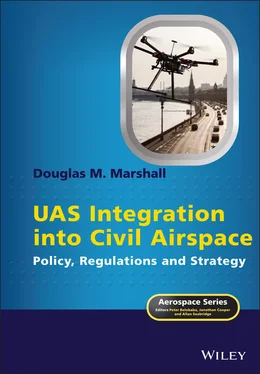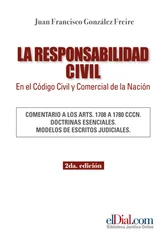With the rapid evolution of UAV technology, aviation regulators at international, national, and local levels have struggled to keep pace with appropriate rules and standards to ensure that UAV systems operate in shared airspace in a safe, equitable, and efficient manner. This book outlines a path forward that minimizes the safety risks while maximizing potential economic benefits for all users of the airspace. In line with the mission of the Aerospace Series, it combines elements of engineering and emerging technology with an accessible discussion of the important related legal and regulatory issues.
Peter Belobaba, Jonathan Cooper, and Allan Seabridge
I gratefully acknowledge the contributions of the following people: Michael Baum for listening to me and in some respects collaborating with me on a previous book; Peter La Franchi for providing valuable information from his perch in Australia; and of course, Sandi for her encouragement and support through the evolution of this book.
1 Background
Introduction
Every civilized nation has some form of rules, regulations, policies, and laws that regulate economic activities and social behaviour. The scope and process for the creation of these guidelines varies widely among nations, depending upon many factors that derive from the form of government and cultures that produce those rules. As a society grows more open and more complex, more rules and regulations may become necessary to maintain order and protect people from harm that may result from the unrestricted activities of others. Those harms can be physical, health related, economic, environmental, or any number of potentially damaging outcomes from a governmental entity, an organization, or an individual doing or failing to do something that threatens the well-being of others. As the technology of unmanned aircraft systems has evolved and more potential users seek to deploy them for recreational, commercial, scientific, or public safety purposes, national and local governments have attempted to address the challenges presented by the integration of remotely piloted aircraft into national civil airspaces, particularly the perception of increased risk of harm to persons or property, by developing regulations that address the risk management and policy issues resulting from the use of these devices.
Since there is no settled overarching international law, treaty, or body of community-based standards that governs unmanned aerial systems (although several such efforts are underway), the developer, manufacturer, distributor, and end user must be wary of the potential for inadvertent violations of existing law, or of having a formerly permitted activity become illegal or proscribed as a result of a change in the rules. Methodologies for understanding the existing rules and participating in the process of developing new or modified rules should be key elements in the business plan for any individual or entity seeking to participate in the unmanned systems arena. Likewise, government regulators can benefit from comprehensive and adaptable criteria for the development of new technologies and the safe integration of those technologies into complex airspace systems.
Setting the Stage for Integration of Remotely Piloted Aircraft into Non-segregated Airspace
Like the oceans, the world’s airspace is a public resource, owned by no one. Territorial waters adjacent to continents, islands, and land masses are controlled by the nations that claim sovereignty over the land contiguous to the oceans. International treaties such as the United Nations Conference on the Law of the Seas (UNCLOS) and United Nations Convention on the Law of the Seas (LCOS) establish the criteria for recognition and structure of national territorial waters, setting limits on the extent of those waters and economic zones. There are dozens of such treaties, conventions and instruments dealing with every conceivable aspect of human management of the world’s oceans. Disputes often arise about the interpretation of treaty language and there is a forum to resolve those disputes. “Peaceful settlement of international disputes occupies an important place in international law in general and the law of the sea is no exception” (Tanaka 2012). The same can be said for the treaties and conventions that deal with international airspace, specifically the Convention on International Civil Aviation (also known as the Chicago Convention of 1944), which created the International Civil Aviation Organization (ICAO). The similarity between the legal regimes of international and domestic airspace and the high seas (and coastal waters) bears examination, for many aviation regulations are derived from ancient maritime common law.
The Law of the Sea and the Law of the Air
Perhaps the greatest challenge to lawmakers and regulators charged with maintaining an acceptable level of safety in their respective national airspace systems is how to integrate unmanned aircraft into existing aeronautical environments where manned aircraft have been navigating with ever increasing levels of safety for decades. The law of the sea evolved over centuries of commercial shipping activities, and is one of the oldest branches of public international law (Tanaka 2012). The law of the airways has a relatively shorter life, but it has progressed and expanded at a far greater pace than the law of the sea. What makes the laws of the sea and the air similar enough to warrant comparison, and perhaps guidance for aviation professionals and regulators, is that both bodies of law, policy, and regulation deal with access to and the safety of a vast common community resource, to wit: the oceans and the airspace above the Earth and the high seas. While it seems unlikely that two vessels navigating the vastness of the world’s oceans could ever collide, they do, far more often than may commonly be known. The European Maritime Safety Agency Annual Overview of Marine Casualties and Incidents 2018 reported an average of 3315 occurrences per year for the four years ending in 2017. In 2017 more than 1500 cargo ships were involved in accidents that resulted in 25 fatalities. Casualties numbered 1018 persons, half related to issues of a navigational nature, such as contacts, grounding/stranding, and collisions. The same observation could be made about the skies. The skies are immense, seemingly limitless, yet airplanes collide, often with catastrophic results. Thus, in both realms, the sea and the sky, regulations and “rules of the road” are necessary to minimize the risk of such events. The aviation rules for airplanes occupying the same airspace in close proximity to one another generally follow the rules at sea (for example, “… when aircraft of the same category are converging at approximately the same altitude [except head-on, or nearly so], the aircraft to the other’s right has the right-of-way”; similarly, “… when two power-driven vessels are meeting on reciprocal or nearly reciprocal courses so as to involve risk of collision each shall alter her course to starboard so that each shall pass on the port side of the other”).
A Brief History of Aviation Regulations
Although the first powered flight with a pilot on board is attributed to the Wright Brothers (specifically with Orville, the daring one, at the controls) at 10:35 a.m. on 17 December 1903 near Kitty Hawk, North Carolina, the first aviation regulations did not appear for another eight years when Great Britain passed the Aerial Navigation Act of 1911. The British followed that law with a second Aerial Navigation Act of 1913, which transferred the control of aviation activities to the Secretary of State for War. In 1916 the British Air Board was created, which greatly influenced the post-World War I control of civil aviation in Great Britain (Chaplin 2011).
Читать дальше












